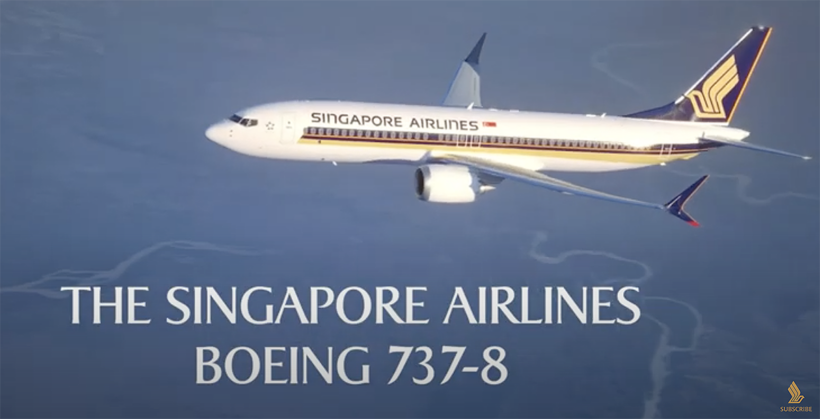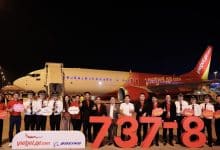Is the new Boeing 737 Max safe to fly? A new book makes you wonder.

The photo is of the new Singapore Airlines Boeing 737-8. Except it’s not really. It’s a Boeing 737 MAX, the most controversial engineering makeover of the past 20 years. Singapore Airlines just don’t want you to know that it’s a ‘MAX’ with all the safety baggage that monicker now carries.
A new book is out “Flying Blind — The 737 MAX Tragedy and the Fall of Boeing”, published by Doubleday. It’s a book you need to read if you fly on commercial planes. It’s out on the book shelves at the same time Indonesian flying authorities lift a ban on the latest Boeing 737 model, more than 3 years after a Lion Air disaster that saw the loss of all 189 people on board, just off Jakarta.
Investigative journalist Peter Robinson catalogues a litany of key failings that were eventually responsible for the deaths of 346 people and how the incidents eventually revealed, what Peter describes as, “the rotted culture of an iconic American company”. His book lays out the argument that these ‘incidents’ were not ‘accidents’ and that the loss of lives of all 346 were totally avoidable.
Take the story of Curtis Ewbank who would eventually be redeemed after walking out of Boeing in 2015, three years before the first crashes of the 737 MAX occurred.
He was a Boeing flight control engineer who raised concerns about the safety of a new flight control software that was designed to correct odd flight characteristics imposed on the plane after newer, larger, heavier engines were added to the 50 year old design.
Boeing originally launched the 737 back in 1967 and had twice rolled out updates for the platform. They were updates that wouldn’t require retraining for the pilots – a key cost for airlines introducing new model aircraft.
To squeeze just one more makeover out of the 737 design, without starting a new clean-sheet single-aisle jet, Boeing rushed into a series of mis-steps which eventually ended up in the deaths of 349 people.
The new, large, turbo fans would offer a 10-15% reduction in fuel burn… that was very attractive to new customers after Airbus had offered a similar upgrade of the newer generation jet engines on their A320 platform… that aircraft would be called the A320 NEO and forced Boeing’s hand to come up with a competitive solution, quickly.
The main difference was the original Airbus design had a lot more ground clearance, allowing a larger engine to fit under the wing. For the ageing Boeing 737, closer to the ground, the larger engines were simply unable to fit under the wing so needed to be located further forward, and mounted higher up on the wing. Looking from the front of the plane it is clear that the top of the engine cowling is now above the wing, before it was below.
This move altered the critical flight balance of the plane. No problem, come up with software to re-trim the plane’s balance whilst it was flying. That software would be called MCAS, the Maneuvering Characteristics Augmentation System.
The Boeing software engineers knew about it, but the pilots of the new model MAX didn’t. And when the system went rogue, the pilots were unaware of how to disable the system that pushed the nose of the plane down when fed faulty information from the Angle of Attack sensors.
In both crash cases, the flight crews battled for a number of minutes with the rogue software, unable to counteract the terrifying pitching of the nose downward.
Curtis Ewbank urged his Boeing bosses to implement a back-up system. They had a back up on the Boeing 787 Dreamliner, so why not the same redundancy for the 737 makeover?
But Curtis explains that Boeing management were worried about the cost overruns on the project. Frustrated, Curtis Ewbank would quit Boeing just 3 years before his worst fears were realised. In the book he quoted the management as saying… “People have to die before Boeing will change things.”
But even after the first crash of a Boeing 737 MAX, the aircraft manufacturers’ management would try and push the blame onto the dead pilots and the airline, Lion Air.
On October 29, 2018 a Lion Air Boeing 737-MAX plunged into the sea just off the Jakarta coast at over 800 kilometres an hour, killing all 189 people on board.
Then on March 10, 2019, another new 737-MAX crashed just after take-off from Addis Ababa in Ethiopia. 157 passengers and crew died in that incident.
Both aircraft were virtually new.
And in both cases it was found that the wayward MCAS software was triggered on the two planes by a faulty angle of attack sensor, sending inaccurate information about the nose-up attitude of the planes. There was no redundancy in the AoA sensor either. The pilots were unable to override MCAS… they didn’t even know about it.
The two MAX crashes would bring Boeing to its knees, exposing a decades-long toxic culture of cost-cutting and compromises that led the death of 346 people.
The book’s author points to a few key moments in the downward spiral, one being the merger with rival McDonnell Douglas in 1996. The ‘new style’ McDonnell Douglas business culture infiltrated Boeing’s management and put responsibilities to shareholders further up the priority chain.
The resulting business culture clash would bring about the largest white-collar strike in US history with over 23,000 Boeing workers walking out. Boeing bosses eventually caved in but the management riff had cost them $750 million USD.
CEO Jim McNerney started work at Boeing in 2005 on a salary of US$52 million and a promise to cut costs in the manufacturing behemoth. It was also the time when the European-based Airbus were starting to really cut into the Boeing business and compete for orders for new planes, even with some of the US Airlines.
McNerney had worked at General Electric and 3M, and would fire about 10% of Boeing’s management during his tenure. He was also the one that decided an all-new Boeing competitor to the new-engined Airbus A320 would be too expensive, and slow, to bring to market and that they’d have to figure out another upgrade for the 50 year old 737 design.
Critically, he also greenlit Boeing’s new upgrade, the 737-MAX, in 2011.
Describing the new version, one former Boeing pilot told the author… “It’s a pig with lipstick’. Another employee went on record saying that the 737 Max was…. “Designed by clowns, who in turn are supervised by monkeys”.
Buyers of the fatally-flawed aircraft would even be expected to add an Angle of Attack gauge to the 737 Max as an optional extra, with a list price of US$80,000. Neither of the two crashed aircraft had these vital gauges on their planes.
Even worse, Boeing refused to make any changes to the 737 MAX that required existing pilots to retrain in expensive simulators.
McNerney would retire in 2015, passing over the project to Dennis Muilenburg who had worked at Boeing since 1985 and was CEO of Boeing’s defense space and security businesses.
Then there was the whole “baffle them with bullshit” approach Boeing used to push through the registration and approval of the rehashed 737 MAX aircraft. Another long list of issues were uncovered in the ‘cosy’ relationship between Boeing and the industry umpire, the US Federal Aviation Authority.
Then the first 737-MAX crashed in Jakarta. Appearing on Fox Business, Boeing’s CEO Muilenburg all but blamed Lion Air and the pilots for the tragedy. He kept re-iterating that safety was a core value for Boeing. But Robinson’s book clearly indicates that Muilenburg’s words did not stack up with the evidence presented.
Then the FAA’s Aircraft Certification Service calculated that there might be as many as 15 more 737 MAX crashes unless MCAS was fixed…. based on the potential size of the MAX fleet, the hours in the air and the possibility of pilots not being able to cope in the event of an Angle of Attack sensor failure.
But Boeing and the FAA appeared “OK” with those odds and the MAX kept flying. After all, no Americans had died so far.
Then an Ethiopian Airlines 737 MAX crashed, killing everyone on board. This, after 25 of the Max model planes had experienced “some sort of safety issue” in the months after they had been delivered to their airlines, according to Robinson’s book.
In 2018, there was one fatal crash in every 3 million flights. The Boeing MAX had a fatal accident rate of one in every 200,000 flights, taking flying safety rates back nearly 70 years
Boeing, with the support of the US flying authorities, wanted to keep the new 737 flying, but the rest of the world could see there was a problem. China was first to ground the MAX in March 2018, just days after the crash of the Ethiopian Airlines plane. Eventually the 737 MAX was grounded worldwide on March 13, 2018.
It would take another 2 years for Boeing to convince the US FAA that the problems had been fixed and get clearance to allow the MAX to fly again. Software upgrades, wiring and pilot training all had to be completed… in all it ended up costing Boeing some 20 billion dollars.
Now the MAX model are starting to pop up around the world again, with some of the airlines marketing the planes without the ‘MAX’ monicker. Singapore Airlines is marketing the wonders of their new single-aisle Boeing fleet as the Boeing 737-8.
So is the Max model safe to fly? According to world aviation authorities… yes. But, the critical aircraft balance has never been resolved. The new, larger, heavier engines are still hanging further forward, with the trust line higher up, on the wing. But, for all intents and purposes, the upgraded software, along with proper pilot training, has won the day with worldwide aviation authorities believing that the software will be a sufficient safety barrier against any future mishaps.
We should also add that the problems mentioned in this article are specific only to the Boeing 737 Max and that similar issues have not affected Boeing’s other aircraft.
In Thailand, only Thai Lion Air took delivery of three 737 MAX Aircraft for its fleet but it cancelled its order for nearly 100 more and have since ordered new Airbus 320 Neo aircraft instead.
Flying in planes, in the third decade of the 21st century, is remarkably safe. And there’s no doubt that this particular model has had a major microscopic look into all facets of the plane’s safety. But there will be segments of the flying public that remain just a little suspicious of how the model came to be, the inherent design flaws that still exist, the callous response from Boeing, and the memory of those 2, horrific, but preventable crashes, and the lives of the 346 people that perished.
“Flying Blind — The 737 MAX Tragedy and the Fall of Boeing” by Peter Robinson is now available at all online bookstores.
Latest Thailand News
Follow The Thaiger on Google News:


























